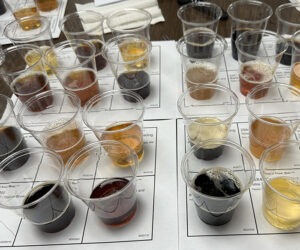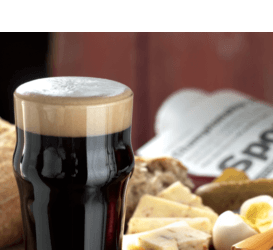SMaSH Brewing: Tips from the Pros
SMaSH (Single Malt and Single Hop) brews are a great way to learn about ingredients, in addition to being some of the simplest beers to make, but that doesn’t mean they can’t also taste great. Two pro brewers with SMaSH beers among their flagships offer advice to brew your own SMaSH.

Kerry Richardson is the Head Brewer and Owner of Last Stand Brewing Co. in Austin, Texas.
When we opened Last Stand back in 2014 we introduced a SMaSH series of beers with a focus on highlighting how hops impact the flavor of beer and how each variety of hop differs from each other. SMaSH beers are a great way to really experience the flavors and aromas extracted from the hops in the brewing process, and we have continued the series with dozens of hop varieties used to date. Citra® was the second hop variety we did in the series and it immediately stood out to the staff and our customers. It quickly became our number one selling beer and we found ourselves drinking it more often than not so we knew we had something special with that recipe. That beer became a year-round offering since not long after the first batch was brewed and has remained our number one selling beer to this day.
We tend to focus on the hops when brewing a SMaSH beer, but we have experimented a little with different base malt from German Pilsner, English Maris Otter, pale malt, as well as lighter Munich malts. But we generally tend to start with either a Pilsner or pale malt so that the hops are the star of the show. Like with malt, we have done several different yeast strains like Dry English, London Ale III, and a few lager strains as well. That said, Citra SMaSH IPA uses a neutral West Coast IPA strain and that’s what we usually start with.
Our SMaSH beers tend to gravitate toward IPA recipes (though we have done SMaSH Pilsners as well). For the IPAs we usually start with a first wort addition, then a late-boil addition followed by a whirlpool addition. Then we finish off with a healthy dry hopping.
In addition to being a great way to evaluate individual ingredients, we also like to take SMaSH beers and blend them at different ratios to see how hops play together. Those experiments help us with recipe development and ratios of hop additions.
In addition to Citra®, other favorites of ours include Mosaic®, Simcoe®, and Centennial. We recently brewed with one of the newer hop varieties, Nectaron®, and the reception was very reminiscent of back when we brewed Citra SMaSH the first time. We’re looking forward to getting more Nectaron® to do more experimenting in the future.
For homebrewers wondering where to begin with SMaSH brewing, like with any other recipe, start with good water. Make sure it’s free of chlorine and/or chloramines. I’d recommend a water test kit so you have a baseline of what your water profile is and then adjust from there with salts, or use reverse osmosis water and build up with salts if you prefer. From there I’d start with a pale or Pilsner malt and choose a hop to brew with. Once you’ve designed a recipe you like and are able to brew it consistently, then try changing the base malt or the yeast to see how that changes the flavor of the beer. I’d only change one ingredient at a time so you can see directly how it impacts the beer. I’d also suggest brewing multiple batches with slight changes close together so you can taste side-by-side.
Another thing to consider as part of SMaSH experiments is how the hop flavor/aroma changes over time. This is a great way to see which hops have “staying power” and which fade away quickly. We have found that some hop varieties fade very fast and some stick around for a while.

Ian Conboy is the Head Brewer and Vice President of Lucky Hare Brewing Company in Hector, New York.
At Lucky Hare we have actually produced very few SMaSH beers only because the first one we made, Live Action, was a hit. That recipe is 100% Pilsner malt, water, Mosaic® hops, and Kölsch yeast. Twenty IBUs of hops are added at 60 and 20 minutes, then there is a whirlpool addition and we dry hop at 2 lbs./barrel (about 1 oz./gallon or 7.5 g/L). The beer is fermented in the low 60s °F (~16 °C) until the beer is about eight gravity points from terminal and then warmed up for a diacetyl rest.
I used Kölsch yeast the first time because that was what I had that was freshly harvested and looking for some wort. It was a wonderful gamble that has led to a beer that we now make on our 15-bbl brewhouse four times throughout the year.
The intention of the SMaSH we brewed was to highlight Mosaic® hops to the fullest. When considering making a SMaSH you need to maximize flavor while achieving balance from only four ingredients. With Live Action, we feel we were able to do this by fermenting with Kölsch yeast instead of our usual Chico strain.
Being able to bitter, add flavor, whirlpool, and dry hop all with one hop variety in SMaSH beers really showcases the flavors and aromatics that are created. This can be said for yeast too — vary your fermentation temperature or the strain and create a plethora of flavor profiles. I have always considered doing the beer with a thiolized yeast strain, or perhaps even going the lager route. The SMaSH concept creates a ton of versatility in the hop and yeast department.
One thing to keep in mind with SMaSH brewing is that there isn’t much to hide behind with just four ingredients if any flaws find their way through. Understanding the entire process of making a beer is key. You must also understand what you are trying to achieve with only those ingredients. Keep notes, don’t take it too seriously, and have fun. With just four ingredients, what’s the worst that can happen?



